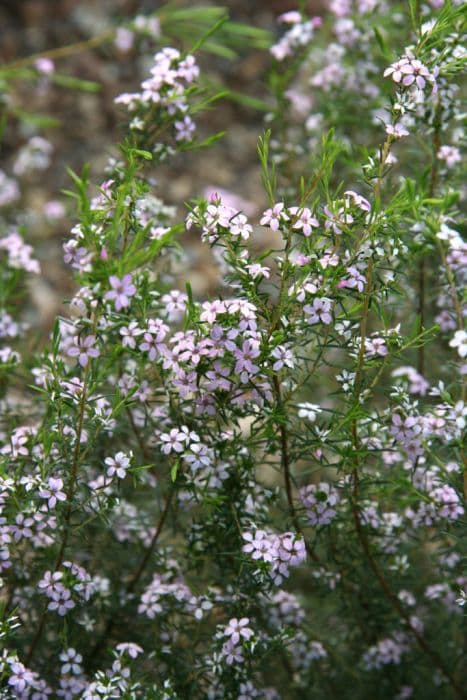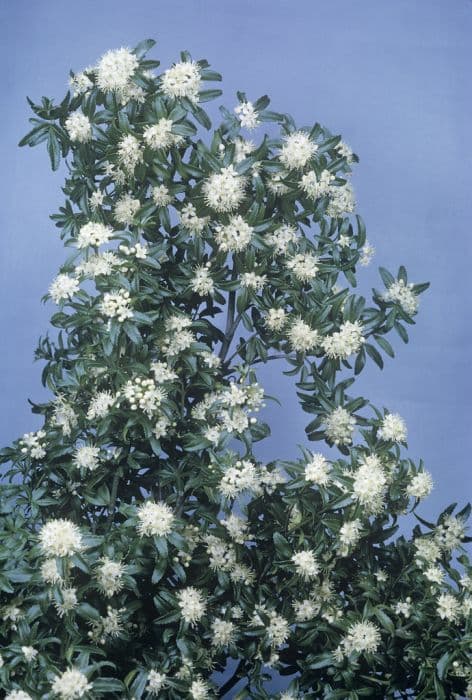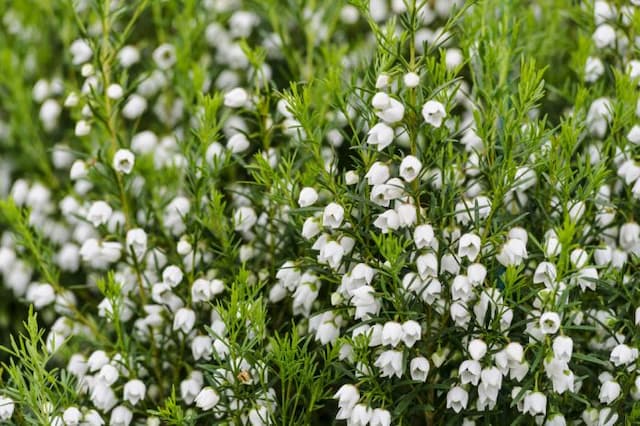Mexican Orange Blossom Choisya × dewitteana Apple Blossom = 'Pmoore09' (PBR)

ABOUT
Apple Blossom is a striking ornamental plant known for its unique and enchanting aesthetic. It's characterized by dense, glossy green leaves that provide a lush backdrop to its main attraction: the blossom. The flowers are reminiscent of apple blossoms, as suggested by the name, with a delicate pastel pink and white color palette. They are shaped like stars, adding a whimsical touch to the plant's appearance. The blooms are often grouped in clusters, which adds to the visual impact of the flowering season. Their fragrance is another notable feature, offering a sweet and inviting scent that can enhance any garden atmosphere. Overall, Apple Blossom presents a harmonious blend of color, fragrance, and form that can bring a touch of springtime charm to any setting.
About this plant
 Names
NamesFamily
Rutaceae
Synonyms
Mexican Orange Blossom, Mexican Orange, Choisya Apple Blossom
Common names
Choisya × dewitteana Apple Blossom = 'Pmoore09' (PBR).
 Toxicity
ToxicityTo humans
The Mexican Orange Blossom is not known for being particularly toxic to humans. However, as with many plants, it is not intended for consumption and may cause mild stomach upset if ingested in large quantities. Since it is not typically associated with severe toxicity, there are no specific symptoms of poisoning widely recognized or reported for accidental ingestion of this plant.
To pets
Mexican Orange Blossom is generally considered to be of low toxicity to pets. Ingestion may cause some gastrointestinal discomfort, such as vomiting or diarrhea, but it is not known to cause severe toxic reactions. Nevertheless, it is advisable to prevent pets from eating this or any ornamental plant to avoid potential stomach upset.
 Characteristics
CharacteristicsLife cycle
Perennials
Foliage type
Evergreen
Color of leaves
Green
Flower color
White
Height
5 feet (1.5 meters)
Spread
5 feet (1.5 meters)
Plant type
Shrub
Hardiness zones
7
Native area
Mexico
Benefits
 General Benefits
General Benefits- Aromatic Flowers: Choisya Apple Blossom produces clusters of pink-white flowers that are heavily scented, providing a delightful fragrance in the garden.
- Ornamental Foliage: It has attractive, glossy green leaves that are evergreen, offering year-round visual interest.
- Low Maintenance: This plant is relatively easy to care for, requiring minimal pruning and upkeep once established.
- Drought Tolerance: It's fairly drought-tolerant, making it suitable for gardens in drier climates or for gardeners who prefer low-water plants.
- Pollinator Friendly: The flowers attract bees and other pollinating insects, which helps to support the local ecosystem.
- Compact Size: Growing approximately 2-2.5 meters tall and wide, it is suitable for small gardens, borders, or as part of a mixed hedgerow.
- Frost Hardy: Choisya Apple Blossom is resistant to frost, allowing it to thrive in cooler climates.
- Versatility in Landscape Design: It can be used for a variety of landscaping purposes, including as a specimen plant, in foundation plantings, or in container gardening.
 Medical Properties
Medical PropertiesThis plant is not used for medical purposes.
 Air-purifying Qualities
Air-purifying QualitiesThis plant is not specifically known for air purifying qualities.
 Other Uses
Other Uses- Choisya 'Apple Blossom' dried leaves can be used to create a natural, aromatic potpourri.
- These fragrant flowers can be infused in oils to make natural perfumes or scented candles, providing a subtle, citrus-like fragrance.
- The stems and branches of the Choisya 'Apple Blossom' can be used in floral arrangements as a green filler to add texture and structure.
- The dense foliage can provide nesting sites for small birds, encouraging biodiversity in the garden.
- Dried and crushed leaves may be sprinkled in areas where pets frequent to provide a fresh, citrus smell and discourage pets from digging.
- Extract from the flowers can be used in homemade natural cleaning products for their scent and mild antibacterial properties.
- The essential oil derived from Choisya 'Apple Blossom' can be mixed with other oils to create natural insect repellents.
- Its ornamental value can be utilized in theme gardens, such as sensory gardens, due to its heavily scented flowers and leaves.
- The white flowers can be used in edible flower concoctions, such as decorating salads or desserts, provided they have not been treated with any chemicals.
- Can be planted in outdoor seating areas or along walkways where the fragrance can be enjoyed by passersby.
Interesting Facts
 Feng Shui
Feng ShuiThe Mexican Orange Blossom is not used in Feng Shui practice.
 Zodiac Sign Compitability
Zodiac Sign CompitabilityThe Mexican Orange Blossom is not used in astrology practice.
 Plant Symbolism
Plant Symbolism- Renewal: The "Apple Blossom" in its name suggests the refreshing quality of spring, when apple trees are in bloom, symbolizing new beginnings and the renewal of life.
- Innocence: Blossoms are often connected with purity and innocence, harking back to the pristine quality of nature.
- Love: Blossoms, including apple blossoms, are frequently associated with love and affection, representing the tender and romantic aspects of love.
- Fertility: The act of flowering implies fruitfulness and fertility, making apple blossom a symbol of abundant growth and the nurturing aspect of nature.
- Beauty: The delicate appearance of this plant's blossoms mirrors the idea of transcendent beauty and the appreciation of aesthetic pleasures.
 Water
WaterThe Mexican Orange Blossom should be watered deeply but infrequently, aiming for about 1 to 2 inches of water per week. During the growing season in spring and summer, it might need water every week, especially in dry conditions. In fall and winter, reduce watering to every two to three weeks, allowing the topsoil to dry out between waterings. If you're using a pot, ensure proper drainage to prevent waterlogging. Pour water slowly at the base of the plant until it begins to run from the bottom of the pot or until the soil is saturated in garden settings.
 Light
LightThe Mexican Orange Blossom thrives in full sun to partial shade. It prefers a spot that gets at least 6 hours of sunlight daily, but it will also tolerate a position with dappled sunlight. Avoid placing it in deep shade, as this can lead to leggy growth and reduced flowering.
 Temperature
TemperatureMexican Orange Blossom prefers temperate conditions and does best when temperatures are between 60°F and 70°F. It can survive minimum temperatures down to around 15°F but may suffer foliage damage. The maximum temperature for healthy growth is around 80°F to 85°F, beyond which the plant may experience stress.
 Pruning
PruningThe Mexican Orange Blossom benefits from pruning to maintain its shape and encourage bushier growth. Prune out any dead or damaged branches in the spring and consider a light trimming after the first flowering to promote a second bloom. Avoid heavy pruning late in the season to prevent damaging new growths that could be susceptible to frost damage.
 Cleaning
CleaningAs needed
 Soil
SoilMexican Orange 'Apple Blossom' prefers well-draining soil with a mix of loam and organic matter, such as compost or peat moss. The ideal pH range for this plant is slightly acidic to neutral, that is, between 6.0 and 7.0.
 Repotting
RepottingMexican Orange 'Apple Blossom' should be repotted every 2-3 years or when it has outgrown its current pot, to ensure continued growth and avoid root overcrowding.
 Humidity & Misting
Humidity & MistingMexican Orange 'Apple Blossom' thrives in moderate humidity levels but is quite adaptable and can survive in lower humidity environments typical of most homes.
 Suitable locations
Suitable locationsIndoor
Place in bright, indirect light and ensure good airflow.
Outdoor
Plant in partial shade, shelter from strong winds.
Hardiness zone
7-10 USDA
 Life cycle
Life cycleChoisya × dewitteana 'Apple Blossom' begins its life cycle as a seed, which when sown, germinates to produce a seedling. The seedling grows into a young plant through the vegetative growth phase, developing a robust root system and foliage. As the plant matures, it enters the flowering stage, usually in late spring, where it produces fragrant pink-tinged white flowers that attract pollinators. After pollination, if it occurs, the plant may produce small fruits with seeds, allowing for the potential of new plants if the seeds are dispersed and find suitable conditions for germination. Throughout the growing seasons, 'Apple Blossom' undergoes cycles of growth and dormancy, typically with a dormant phase in the winter when growth slows down significantly or stops. With appropriate care and favorable conditions, this perennial can live for many years, continuing its cycle of seasonal growth and dormancy.
 Propogation
PropogationPropogation time
Spring-Early Summer
Choisya × dewitteana 'Apple Blossom', more commonly known as Mexican Orange Blossom, can be most effectively propagated through semi-hardwood cuttings. The best time to take these cuttings is generally in late summer, once the new growth has matured slightly and taken on a more semi-hardwood texture but is not yet fully hardened. To propagate, cuttings approximately 4 to 6 inches (about 10 to 15 centimeters) in length should be taken, with the lower leaves removed to expose a clean stem. It's crucial to dip the cut end into a rooting hormone to encourage root development before planting the cutting in a well-draining potting mix. Once planted, the cutting requires a warm, well-lit environment and must be kept consistently moist, but not waterlogged, until roots have formed and the plant is ready to be potted on or planted out.








![Mexican orange [Sundance]](/_next/image?url=https%3A%2F%2Fplants-admin.emdemapps.com%2Fimages%2Fplants%2F%2Fimages%2F604b5381bcf0d.png&w=640&q=75)
